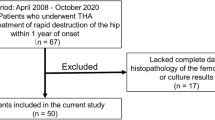Summary
Serial measurements of C-reactive protein (CRP) levels and erythrocyte sedimentation rates (ESR) were performed during the week after operation in 140 patients with hip fractures. There was no selection, and patients with minor or major complications before or after operation were included. In uncomplicated cases, the ESR was variably raised during the first week, whereas the CRP showed a distinct pattern with a rapid increase on the second day; it then decreased by the 7th day. In cases with early postoperative bronchopneumonia and deep wound infection, the CRP was high, but minor infections did not influence the usual levels. Complications had no effect on the ESR during the 1st week.
Résumé
Cent-quarante patients opérés pour fracture de la hanche, par hémiarthroplastie ou par ostéosynthèse, ont été soumis la première semaine post-opératoire, à des mesures sériées du taux de C. réactive protéine (CRP) dans le sérum et de la vitesse de sédimentation (V.S). Nos mesures n'ont pas étés triées et ont inclus les patients présentant des complications mineures ou majeures pré- ou post-opératoires. Dans les cas sans complications, le taux de la V. S s'élève de façon variable durant la semaine, tandis que la CRP présente une courbe différente avec une augmentation rapide des valeurs de base jusqu'à un maximum, d'une valeur moyenne de 1452 nmol/l au deuxième jour post-opératoire. Dès lors, les taux régressent à une valeur moyenne de 352 nmol/l au septième jour. Du deuxième au cinquième jour les taux de CRP baissent de 61%, du deuxième au septième jour de 76%. Dans les cas de pneumonie post-opératoire et d'infection locale profonde, les taux de CRP sont restés significativement élevés, tandis que les infections mineures telles que simple cystite, bronchite ou infection superficielle de la plaie n'ont pas influencé les variations normales post-opératoires des taux de CRP. A l'inverse, les complications post-opératoires n'ont aucun effet sur la V. S durant la première semaine. Il semble donc que les mesures sériées de la CRP constituent un paramètre plus fiable que celles de la V. S dans le dépistage précoce des complications septiques majeures post-opératoires.
Similar content being viewed by others
References
Aalto K, Österman K, Peltola H, Räsänen JA (1984) Changes in erythrocyte sedimentation rate and CRP after total hip arthroplasty. Clin Orthop 184: 118–120
Drahovsky D, Dunzendorfer U, Ziegenhagen G, Drahovsky M, Kellen JA (1981) Reevaluation of c-reactive protein in cancer by radioimmunoassay and radial immunodiffusion. Oncology 38: 286–291
Fischer CL, Gill C, Forrester MG, Nakamura R (1976) Quantitation of “Acute-phase Proteins” postoperatively. AJCP 66: 840–846
Fehr J (1988) Die klinische Bedeutung des CRP-(C-reaktiven Protein-) Monitoring. Ther Umsch Rev thér 45: 85–92
Gadsbøll N, Høilund-Carlsen PF (1983) C-reaktivt protein. Ugeskr Laeger 145: 1128–1131
Gelin L (1956) Studies in anemia of injury. Acta Chir Scand (Suppl) 210: 1
Jenny G, Schaub JM, Férard G, Métais P, Kempf I (1986) Intérèt du dosage de la C. réactive protéine dans l'infection ostéo-articulaire. Rev Chir Orthop 72: 197–201
Kenny RA, Hodkinson HM, Cox ML, Caspi D, Pepys MB (1984) Acute phase protein response to infection in elderly patients. Age Ageing 13: 89–94
Kindmark CO (1972) The concentration of c-reactive protein in sera from healthy individuals. Scand J Clin Lab Invest 29: 407–411
Mustard RA, Bohnen JMA, Haseeb S, Kasina R (1987) C-reactive protein levels predict postoperative septic complications. Arch Surg 122: 69–73
Peltola H, Räsänen JA (1982) Quantitative CRP in relation to erythrocyte sedimentation rate, fever and duration of antimicrobic therapy in bacteremic diseases of childhood. J Infection 5: 257
Pepys MB (1981) C-reactive protein fifty years on. Lancet I: 653–657
Sanzén L, Carlsson ÅS (1989) The diagnostic value of C-reactive protein in infected total hip arthroplasties. J Bone Jt Surg [Br] 71: 638–641
Shih LY, Wu JJ, Yang DJ (1987) Erythrocyte sedimentation rate and C-reactive protein values in patients with total hip arthroplasty. Clin Orthop 225: 238–246
Schulak DJ, Rayhack JM, Lippert III FG, Convery FR (1982) The erythrocyte sedimentation rate in orthopedic patients. Clin Orthop 167: 197–202
Author information
Authors and Affiliations
Rights and permissions
About this article
Cite this article
Ellitsgaard, N., Andersson, A.P., Jensen, K.V. et al. Changes in C-reactive protein and erythrocyte sedimentation rate after hip fractures. International Orthopaedics 15, 311–314 (1991). https://doi.org/10.1007/BF00186867
Issue Date:
DOI: https://doi.org/10.1007/BF00186867




